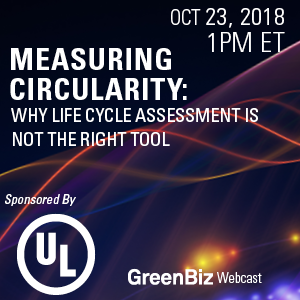Measuring Circularity: Why Life-Cycle Assessment Is Not the Right Tool

The growing interest in circular materials, products and business models is creating demand for a new generation of tools and standards to measure and assess circularity. Life-cycle assessment has traditionally been the most valued tool to assess the environmental impacts of a product across its life cycle. But measuring circularity across supply chains — and in a way that is readily accessible to companies at various stages of circularity development — requires different thinking and tools.
This one-hour webcast will examine circular economy metrics, such as the Circular Economy Indicators project — which includes metrics covering product and site-level issues such as recycled content and solid waste from manufacturing — as well as macro-level metrics such as the energy used in the supply chain. You will learn about UL’s Circularity Facts program, which enables the combination of site and product data for an integrated measurement of enterprise circularity, all based on measurements that many companies are already using, and without the extensive data collection effort required by LCA.
You’ll learn:
-
How focusing on material flows at the product and site level can help us understand the circularity of supply chains and local economies
-
How making materials flows or material efficiency visible can eliminate material loss and certain negative externalities of the current linear economic model
-
The 10 ways to measure product-level circularity
-
The difference between how circularity is measured at the site level compared to how waste diversion is measured
- How circularity measurement may continue to evolve in the future
Moderator:
Joel Makower, Editor in Chief and Co-Founder, GreenBiz Group
Speakers:
Bill Hoffman, Senior Scientist at UL Environment
David Rakowski, Managing Consulting, PA Consulting Group
Speakers
Sponsored by

Register Here
Thank You — Invitation Request Submitted
Thank you for your interest in attending this webcast. Please check your email inbox for information and access link.


